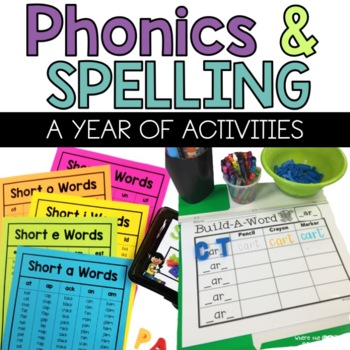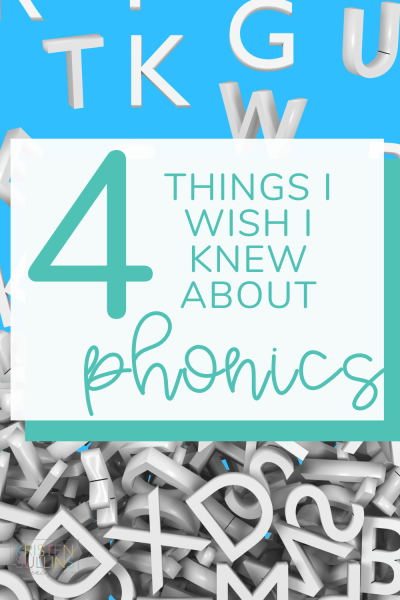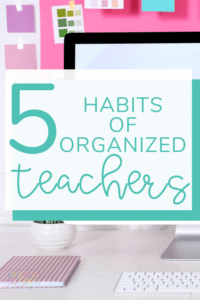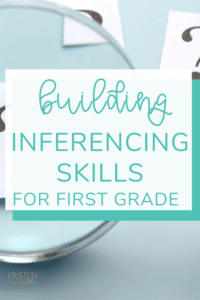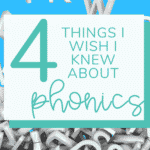The beginning of the school year means a lot of things for a first grade teacher, but one of the most important and effective things you can do is…
zone in on phonics.
Our school recently went big with our phonics instruction and it is really paying off!
The teaching of phonics has changed a lot in recent years and there are so many things I wished I knew less than a decade ago.
When I think back to my first year of teaching, I was focused on the teaching of reading.
It was kindergarten after all, and letters, sounds and sight words were our primary focus.
The teaching of phonics, however, looked NOTHING like it does now.
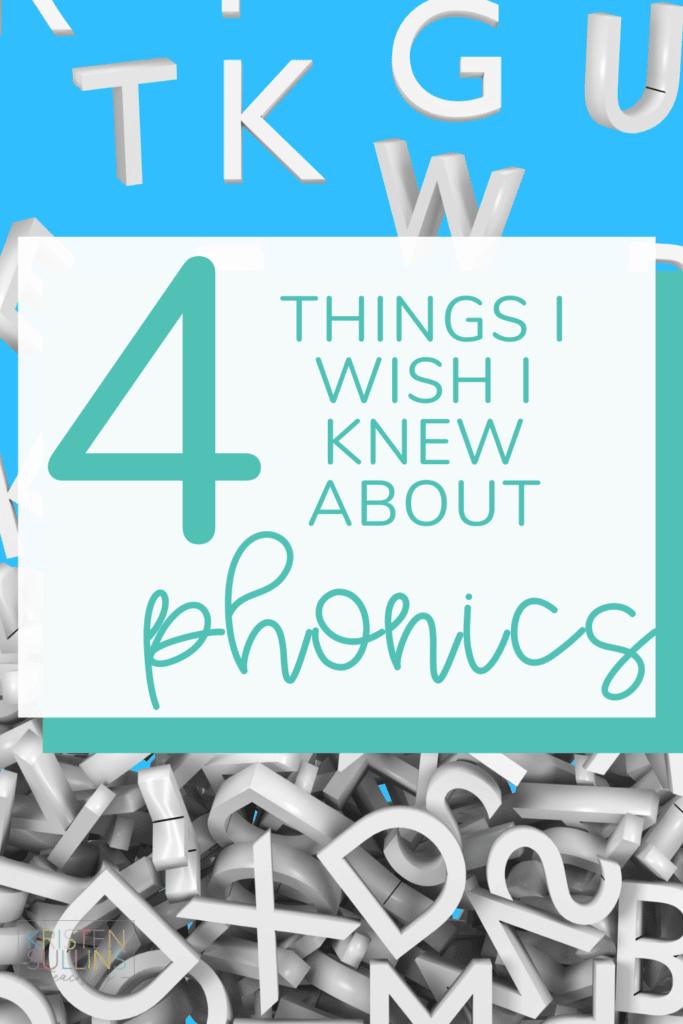
Past Phonics Trends
At the time, we focused on a different letter of the week, honing in on the sounds it makes and how to identify it in words we hear, see and speak.
This was the norm.
I didn’t know any other kindergarten teachers that didn’t approach it this way.
As time went on, we started accelerating the process by doing a different letter a day, rather than a week, but even that is nothing like it looks now.
The things we were doing, and the way we were approaching phonics wasn’t wrong, but it just wasn’t enough.
If you haven’t yet been hit with the terms explicit and systematic instruction, then buckle up.
Here are some of my biggest takeaways from things I’ve learned from teaching first grade phonics in recent years:
#1: Don’t focus on the Alphabet; Focus on the Alphabetic Code
#2 Pronunciation is KEY.
#3 Phonemic Awareness HAS to be a focus.
#4 Blending and Segmenting takes TIME.
First Grade Phonics Tip #1
Don’t focus on the Alphabet; Focus on the Alphabetic Code (phonemes & graphemes) and Make it Snappy!
In Texas we have been required to “attend” a course called the Reading Academy (I say, “attend” because our campus did it all online).
I would compare it to a college course; it took the whole year, and there was SO much information to take in.
Overall, it was great and really helped me gain a better understanding of the teaching of phonics.
Teaching first grade phonics is WAY more than just teaching the 26 letters of the alphabet.
We need to ensure that phonemic awareness and grapheme knowledge are taught as quickly as possible, to give students the opportunity to successfully decode (read) and encode (write) unfamiliar words.
Let’s break this down a little more, what is a phoneme?
It is the smallest unit of sound. – I think to myself: phoneme (PHONE!) it is what you can hear with your ear or say. You don’t see it! Ears only, like when you’re talking on a phone. There are 44 phonemes in the English language.
What is a grapheme?
It is the smallest unit of a written sound. I always try to think of graffiti, you don’t hear it you SEE it.
We want students to know their letters, yes, but this is a totally different approach than just saying “A is for Apple”.
Working with phonemes and being able to manipulate them is just as important, if not more important, than being able to identify the written letter.
This process also needs to be quickly paced. This was my biggest challenge at first because I felt like I was pushing too much on my students.
Not the case!
The more phonemes (sounds!) taught, the quicker we can move to the skills of segmenting and blending those phonemes.
So here is my challenge for you! If you are still introducing 1-2 letters a week, I would like you to increase that number to 3-4!
I wish someone would’ve nudged me more when I first started out.
Tips for teachers and parents
It is O.K. to be flexible with the order in which you present sounds.
Some may need to be introduced earlier because they come up more often.
If something comes up when you are discussing certain sounds that you haven’t covered, cover it!
If you are working on the sound /f/ in conjunction with the letter F, and a student’s name is Joseph, discuss the ph too.
Explicit instruction and exposure to all the graphemes is important.
First Grade Phonics Tip #2
Pronunciation is KEY.
Okay, this is a big one for me.
Accents and dialects will definitely come into play here, and this is something a lot of people don’t think about.
I’m going to give you an example first, then go back and discuss where I’m going with it.
Read the following partial sentence
- “Today in our classroom…”
Now some of you might have said the following “Today in ARE classroom…” and others may have said, “Today in HOUR classroom…”.
— Oh snap!
Did you catch that?
If you are working on the word /our/ in your classroom and pronounce it like /are/, you are going to get some confused kiddos!
Being aware of how we speak is really important. Personally, if you hear me say the word bag, it sounds like beg.
Sorry, that’s just what happens!
If I am teaching and expecting my students to segment, blend, or even write the word /bag/, however, I emphasize the /a/ sound and make sure I say the word CORRECTLY, as hard as that may be for me!
The same not only goes for how we pronounce words, but how we pronounce letters.
This is a HUGE one, and I’m sure a lot of you have heard this by now, but we need to STOP SAYING “uh” at the end of your phonemes.
The sound /uh/ is called a schwa, and basically we use it way too much!
B doesnt say /bUH/, D does not say /duh/ and so on.
It can really impact the way students decode and encode words. If a child is trying to segment the word zip and they say /zuh/ /i/ /puh/, when they go to blend it, they will likely say “zipper”, therefore producing an incorrect word.


Tips for teachers and parents
Practice your phonemes before you teach them. Identify what accent/dialect you may have; just being aware of it will be a huge help to you and your students.
I’ve learned so much about the way I speak from focusing on the way I should be teaching phonemes.



First Grade Phonics Tip #3
Phonemic Awareness HAS to be a focus.
What is the first thing a new elementary teacher buys for their empty classroom?
For me, it was an alphabet strip. How can we teach the alphabet without it, right?
I’ve now realized how LITTLE I knew.
Now, don’t get me wrong, I’m all for an alphabet strip on your classroom wall, but next time you’re looking at it, check to see if the letters and phonemes are correct!
For example, my first alphabet strip had an owl for the letter O”.
It was adorable! BUT this isn’t correct: owl starts with the phoneme /ow/ not /o/. An octopus would’ve been the appropriate animal to use.
But now I’m getting off topic.
The the physical representation of letters IS important, but phonemic awareness is something that HAS to be focused on.
Remember what I said before, phonemes are the smallest unit of sound.
You don’t see it, read it or write it. It is strictly what you hear.
Phonemic awareness is the ability to listen to an individual phoneme in a word, and be able to manipulate it to make new words.
This is vital in being able to read and write.
Tips for teachers and parents
Work on rhyming – I say ten, men and students come up with their own words. OR I say ten, men, hat and students identify the 2 words that rhyme.
Practice segmenting – I say the word cat and students break apart the sound /c/ /a/ /t/.
My students enjoyed chopping the words with their hands like they were chefs in a kitchen and their hands were the knife. Each sound is a different chop.
Robot voices are also great, which I’ll talk about in the next section!
Practice blending – I say the sounds /b/ /a/ /d/, students repeat and then blend to say the word bad. In my classroom we chop the segmented word and then smooth out our hands when we blend the word back together.
First Grade Phonics Tip #4
Blending and Segmenting takes TIME.
This was a tough one for me. When we discuss blending and segmenting, it seems so easy to us. In my mind I thought, “oh that’ll go quick!”.
No, I was wrong.
It takes time and that is OK! Assuming your students will automatically pick-up skills is something we just can’t do.
We all know that each classroom is filled with individuals who are at different places when it comes to just about everything.
We already know we need to approach teaching with flexibility and grace, but sometimes it is hard.
We want to hit the ground running when it comes to certain skills, but there is a reason reading takes time, it is hard!
Blending is an important skill needed for reading and shouldn’t be rushed.
With that being said, you SHOULD start introducing blending as soon as you can.
Once students have been introduced to a few phonemes, you can start introducing words using those sounds.
As you continue to introduce new phonemes, you can practice more blending.
This will build a solid foundation for your students that will increase their self confidence as well as enhance their early reading skills!
This goes too for segmenting, which is the opposite of blending. This skill is required for spelling, as well as reading. As with blending, once a few letter sounds have been introduced you can start working on this!


Tips for teachers and parents
Chopping the word with their hands when segmenting is a great start and students enjoy using larger motor skills when learning. Another thing that students enjoy is robot voice when segmenting and blending words.
Once students have been explicitly taught how to segment and blend, consistent practicing is very important.
Encourage the use of their robot voice until you feel they have a good grasp on the concepts, and then work on having that voice be their inner voice.
Though robot voices can be very helpful when segmenting and blending, we don’t want students reading that way.
Fluency is very important in obtaining the goal of reading: comprehension.
These 4 things have really changed the way I teach and the approach I take to phonics.
I am constantly learning, changing and growing as a first grade teacher.
I feel like that is just the way our field of work is! There is always new research out and new approaches to try.
I hope these 4 things help you in your classroom like they have in mine!
Need First Grade Phonics Activities?
This year long Phonics and Spelling activity bundle is a 5-Part phonics kit for teachers to use when teaching students about spelling and phonics patterns (word families).
Here's what other teachers are saying:
Using this resource for center work at the end of the day. Students are very engaged and successful!
-Kelly S.
This is a fantastic collection of reading resources to use during guided reading groups! Some of my first graders are still working on phonics skills that will help them read fluently. I love this set!
-Ramona K.




